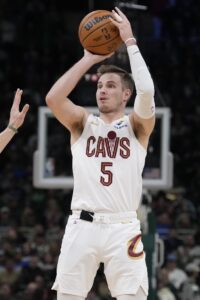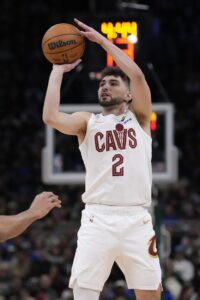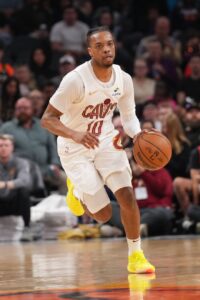Hoops Rumors is checking in on the 2025 offseason for all 30 NBA teams, recapping the summer’s free agent signings, trades, draft picks, departures, and more. We’ll take a look at each team’s offseason moves and consider what might still be coming before the regular season begins. Today, we’re focusing on the Cleveland Cavaliers.
Free agent signings
 Sam Merrill: Four years, $38,000,000. Re-signed using Bird rights.
Sam Merrill: Four years, $38,000,000. Re-signed using Bird rights.- Larry Nance Jr.: One year, minimum salary. Signed using minimum salary exception.
Trades
- Acquired Lonzo Ball from the Bulls in exchange for Isaac Okoro.
Draft picks
- 2-49: Tyrese Proctor
- Signed to four-year, $8,685,386 contract. First two years guaranteed. Third year partially guaranteed ($500K). Fourth-year team option.
- 2-58: Saliou Niang
- Will play overseas.
Two-way signings
- Luke Travers
- One year, $85,300 partial guarantee (will increase to $318,218 at start of regular season).
Departed/unsigned free agents
- Emoni Bates (unsigned)
- Javonte Green (Pistons)
- Ty Jerome (Grizzlies)
- Chuma Okeke (Real Madrid)
- Tristan Thompson (unsigned)
Other roster moves
- None
Salary cap situation
- Operating over the cap ($154.6MM) and above the luxury tax line ($187.9MM).
- Carrying approximately $226.3MM in salary.
- No hard cap.
- One traded player exception frozen ($8,500,000).
- One traded player exception available ($1,000,000).
The offseason so far
When the Cavaliers fell to Indiana in the second round of the playoffs this spring, it was a gut punch for a couple reasons. First and foremost, it was an incredibly disappointing way to end what had been one of the best years in team history up until that point. Only the 2008/09 Cavs – propelled by an MVP season from an in-his-prime LeBron James – racked up more regular season victories than the 64 last season’s club won.
It was also a discouraging outcome because it happened right before the Cavs’ roster was set to get significantly more expensive. Cleveland managed to duck below the luxury tax line at February’s deadline, but even without re-signing any key free agents, the team’s salary for 2025/26 was set to enter second-apron territory.
 After the Suns, Celtics, and Timberwolves got a first-hand look last season at the impact of operating in the second tax apron, those teams were all in the process of moving below that threshold this summer. Would the Cavs really be willing to go deeper into the second apron in order to re-sign guys who played key roles for the 2024/25 squad, such as Ty Jerome and Sam Merrill?
After the Suns, Celtics, and Timberwolves got a first-hand look last season at the impact of operating in the second tax apron, those teams were all in the process of moving below that threshold this summer. Would the Cavs really be willing to go deeper into the second apron in order to re-sign guys who played key roles for the 2024/25 squad, such as Ty Jerome and Sam Merrill?
As it turns out, the answer was yes — to a point. The Cavs didn’t hesitate to negotiate a new multiyear deal with Merrill, who established himself as one of the club’s best shooters and whose defense has improved significantly since he entered the league. The two sides reached an agreement on a four-year, $38MM contract two days before the league-wide free agent period opened, keeping Merrill off the market.
While that contract is fully guaranteed, it’s only worth about 5.5% of the cap in year one and will remain in that neighborhood over the next four years. It’s a fair deal for a rotation player who figures to average 20-plus minutes per game and who won’t be played off the floor in the postseason — as a point of comparison, another Eastern Conference wing who plays a similar role, Boston’s Sam Hauser, will be paid $45MM over the same four-year period.
Although Cleveland made Merrill a priority, the front office didn’t do the same for Jerome, whose breakout year earned him a third-place finish in Sixth Man of the Year voting.
As good as Jerome was, he was exposed defensively in the playoffs, and the Cavs likely didn’t feel the need to invest heavily in another offense-first guard while already paying big bucks to Donovan Mitchell and Darius Garland — especially since doing so would have cost them exponentially more in tax penalties. After agreeing to a three-year, $27.7MM deal with the Grizzlies, Jerome suggested in a social media post that he was “never presented with the option of returning” to Cleveland.
Like the decision to pass on Jerome, the other Cavaliers’ moves were made with financial considerations in mind. That includes their straight-up trade of Isaac Okoro for Lonzo Ball. Okoro ($11MM) will only earn slightly more in 2025/26 than Ball ($10MM), but Okoro’s contract is guaranteed through the 2026/27 season, while the Cavs will hold a team option for Ball in ’26/27, giving them some extra financial flexibility.
Of course, swapping a wing for a point guard also made sense from a roster construction standpoint after having re-signed Merrill and not Jerome.
Although Ball returned last season from a two-and-a-half-year injury absence related to recurring knee problems, he still wasn’t exactly a paragon of health, having appeared in just 35 games. If he can bump that number to at least 50-60 appearances in 2025/26, it would be a major boon for the Cavs, since Ball has a knack for making his team better even when his box-score numbers don’t look all that impressive.
The Cavs used one of their second-round picks to select former Duke guard Tyrese Proctor and sign him to a multiyear contract that starts at the rookie minimum. The gap between cap hits for a rookie minimum salary ($1,272,870) and a veteran minimum salary ($2,296,274) isn’t massive, but when a team is as deep into luxury tax territory as Cleveland is, the savings represent far more than that modest difference suggests.
Proctor spent three years with the Blue Devils and should be more NBA-ready than a one-and-done prospect, but he’s still just 21 years old and may not be prepared to contribute right away. That would probably be OK with the Cavs, who figure to focus on developing Proctor’s game in the hopes that he’ll be ready to take on a more regular rotation role in a year or two.
Finally, the Cavs added some much-needed frontcourt depth by reuniting with Larry Nance Jr. on a minimum-salary agreement. Nance, who was in Cleveland for three-and-a-half seasons from 2018-21, averaged 27.6 minutes per game during his first stint with the organization. This time around, he’ll likely be asked to play a more modest role behind big men Jarrett Allen and Evan Mobley, but – as long as he’s healthy – he’ll be a solid insurance option up front in the event of an injury to either of those players.
Up next
Although injuries to Garland (toe) and Max Strus (foot) are expected to sideline them for the start of the regular season, the Cavs seem unlikely to carry a full 15-man roster due to luxury tax concerns. However, they’ll need to get to at least 14 players on standard contracts, which will require adding one more player at some point in the next month or two.
Despite being limited to minimum-salary offers for veteran free agents, the Cavs have no shortage of options for that 14th spot. If they want to add one more ball-handling guard for depth purposes due to health concerns about Garland and/or Ball, a player like Malcolm Brogdon or Cameron Payne would make sense.
With Strus expected to miss an extended period, one more wing would be a logical choice too — someone like Garrison Mathews, Landry Shamet, or Gary Payton II could fit that bill. Cleveland has also been linked to Malik Beasley, though he remains under investigation by the NBA, and it’s unclear if one of the league’s best sharpshooters will have to settle for the veteran’s minimum.
 The Cavs could even target one more big man to further fortify their frontcourt behind Allen and Mobley, given that Nance is coming off a season-ending knee issue. Precious Achiuwa and Thomas Bryant are among the vets still out there.
The Cavs could even target one more big man to further fortify their frontcourt behind Allen and Mobley, given that Nance is coming off a season-ending knee issue. Precious Achiuwa and Thomas Bryant are among the vets still out there.
Whichever direction they go, I’d like to see the Cavs use that spot on a player who can actually contribute rather than a locker-room leader who won’t see any action — with Garland and Strus already recovering from major injuries, Cleveland isn’t in position to throw away a valuable opportunity to add more playable depth.
The Cavaliers also have one open two-way slot to fill alongside Nae’Qwan Tomlin and Luke Travers. The path they take with their standard roster spot could dictate what position they want to address with that final two-way opening.
Finally, it’s worth noting that several key Cleveland players – Garland, Strus De’Andre Hunter, and Dean Wade – will be eligible for extensions during the preseason. However, Garland, Strus, and Hunter all have multiple guaranteed years left on their current contracts and Wade has been mentioned as a potential trade candidate in the event that the Cavs want to try to reduce their tax bill.
I’d be a little surprised if any of those four players signs an extension before the regular season begins, given Cleveland’s cap situation. The team, which is carrying the NBA’s most expensive roster in 2025/26, probably isn’t eager to lock in more long-term money earlier than it needs to.
Offer Hunter, Strus, Proctor, Lonzo Ball, Wade, cash and picks to LAL for LeBron James and LeBron James Jr
Waive Tomlin and sign a young PF and C on two way contracts
Resign Bates and Thompson
Championship
False
Why?
I low key love this but it’s a no go because Cleveland can’t aggregate salaries as a second apron team
All those words and they are still a soft team that will most likely be injured and pushed around in playoffs in route to another second round exit.
Cavs are team to beat …….
They were banged up against Pacers. But they did underestimated them. So did Knicks and they were healthy. Cavs are still growing cause of their young talent. Garland (25), Mobley (24), Allen (27), Hunter (28), Donovan could be MVP.
This general manager along with Atlanta is doing a much much much much much much much much much much much much much better job than Milwaukee. Fire the GM in Milwaukee. I or anyone on this site could do a better a better job